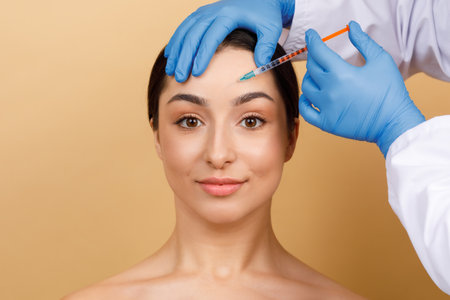1. Introduction to Botox
Botox is one of the most popular cosmetic treatments in the world, known for its ability to reduce fine lines and wrinkles. But what exactly is Botox, and how did it become such a widely used treatment? In this section, well explore the origins of Botox, its medical applications, and why it has gained immense popularity in the beauty industry.
What Is Botox?
Botox is a purified form of botulinum toxin type A, a neurotoxin produced by the bacterium Clostridium botulinum. While high doses of botulinum toxin can be harmful, when used in controlled amounts, it provides significant benefits for both medical and cosmetic purposes. Botox works by temporarily blocking nerve signals to targeted muscles, preventing them from contracting and causing wrinkles.
The Origins of Botox
The story of Botox dates back to the 1820s when German scientist Dr. Justinus Kerner first studied botulinum toxin. However, its modern medical use began in the 1970s when ophthalmologist Dr. Alan Scott discovered that small doses could help treat eye disorders like strabismus (crossed eyes). By the late 1980s, Botox was approved for medical treatments, and in 2002, the FDA approved it for cosmetic use to reduce frown lines.
Why Is Botox So Popular?
Over the years, Botox has gained widespread acceptance due to its effectiveness and minimal downtime. Unlike surgical procedures that require long recovery periods, Botox injections are quick and convenient. Here’s why people choose Botox:
| Reason | Description |
|---|---|
| Non-Surgical | No incisions or anesthesia required. |
| Quick Procedure | Takes only 10-15 minutes per session. |
| Minimal Downtime | Patients can resume daily activities immediately. |
| Effective Results | Smoother skin with visible improvements within days. |
| Versatile Use | Treats wrinkles as well as medical conditions like migraines. |
The Rise of Botox in Cosmetic Treatments
Today, Botox is widely used not just by celebrities but also by everyday individuals looking for a youthful appearance. It’s commonly used to treat forehead lines, crow’s feet, and frown lines between the eyebrows. Many people appreciate that it offers subtle yet noticeable results without drastically altering their facial expressions.
Is Botox Right for You?
If youre considering Botox for cosmetic reasons, its essential to consult with a qualified professional. A skilled injector will assess your concerns and recommend the best treatment plan based on your goals. Whether you’re looking to smooth out wrinkles or prevent future ones from forming, Botox remains one of the most trusted and effective solutions in aesthetic medicine.
2. The Science Behind Botox
Botox works by temporarily blocking nerve signals to specific muscles, preventing them from contracting. This process helps reduce the appearance of wrinkles and fine lines, making the skin look smoother and more youthful. But how exactly does this work on a neurological level?
How Botox Affects Nerve Signals
Botox is derived from botulinum toxin, a purified protein that interacts with the nervous system. When injected into targeted muscles, it prevents the release of acetylcholine, a neurotransmitter responsible for triggering muscle contractions.
The Neurological Process of Botox
| Step | Description |
|---|---|
| 1. Injection | Botox is injected into specific facial muscles using a fine needle. |
| 2. Neurotransmitter Blockage | The toxin binds to nerve endings, preventing the release of acetylcholine. |
| 3. Muscle Relaxation | Without acetylcholine, the targeted muscles remain in a relaxed state. |
| 4. Wrinkle Reduction | The reduced muscle activity smooths out dynamic wrinkles and fine lines. |
| 5. Gradual Wear-Off | The body metabolizes Botox over time, gradually restoring normal muscle function. |
Why Botox Is Effective
The effectiveness of Botox lies in its ability to target only specific muscles while leaving surrounding areas unaffected. This precision allows for natural-looking results without compromising facial expressions. Additionally, Botox treatments are quick, minimally invasive, and require little to no downtime, making them a popular choice for those looking to achieve a more youthful appearance.
How Long Do Results Last?
The effects of Botox typically last between three to four months, depending on individual factors such as metabolism and muscle activity. Regular treatments can help maintain smoother skin and even train muscles to contract less over time, prolonging the results.
![]()
3. Why Botox Is Effective
Botox has gained popularity not just for its ability to reduce wrinkles but also for its effectiveness in preventing fine lines and addressing various medical conditions. Its success lies in its ability to temporarily relax targeted muscles, leading to smoother skin and relief from certain health issues.
Reducing Wrinkles and Fine Lines
One of the main reasons people turn to Botox is its ability to minimize the appearance of wrinkles and fine lines. By blocking nerve signals that cause muscle contractions, Botox helps relax facial muscles, which prevents deep creases from forming.
Common Treatment Areas
| Area | Effect of Botox |
|---|---|
| Forehead Lines | Smooths horizontal lines caused by expressions |
| Crow’s Feet | Reduces fine lines around the outer corners of the eyes |
| Frown Lines (Glabellar Lines) | Softens vertical lines between the eyebrows |
| Bunny Lines | Minimizes small wrinkles on the nose |
| Lip Lines | Decreases vertical lines around the lips (smokers lines) |
| Neck Bands | Relaxes platysmal bands for a smoother neck appearance |
Preventing Future Wrinkles
Beyond treating existing wrinkles, Botox is also used as a preventive measure. Many individuals in their late 20s or early 30s opt for “preventative Botox” to slow down the formation of deeper wrinkles over time. By relaxing frequently used facial muscles, Botox helps reduce repetitive movements that lead to permanent creases.
Treating Medical Conditions with Botox
Apart from its cosmetic benefits, Botox is widely used in medicine to treat various conditions. Its muscle-relaxing properties provide relief for several medical issues:
Medical Uses of Botox
| Condition | How Botox Helps |
|---|---|
| Chronic Migraines | Reduces headache frequency by relaxing muscle tension and blocking pain signals |
| Excessive Sweating (Hyperhidrosis) | Blocks nerve signals responsible for overactive sweat glands |
| TMD and Jaw Clenching | Eases jaw tension by relaxing overactive muscles causing discomfort and grinding |
| Lazy Eye (Strabismus) | Helps correct eye alignment by weakening stronger eye muscles |
| Eyelid Spasms (Blepharospasm) | Relieves uncontrollable eyelid twitching and spasms |
The Versatility of Botox Makes It a Popular Choice
The effectiveness of Botox comes from its ability to provide both cosmetic and medical benefits. Whether someone wants to smooth out wrinkles, prevent future signs of aging, or find relief from a medical condition, Botox continues to be a trusted solution backed by science.
4. Safety and Common Misconceptions
Botox has been around for decades, but there are still many misconceptions about its safety and effectiveness. Lets take a closer look at its safety profile, FDA approvals, and some common myths that need to be debunked.
Is Botox Safe?
Yes! Botox is considered safe when administered by a qualified medical professional. It has been approved by the U.S. Food and Drug Administration (FDA) for both medical and cosmetic purposes. Millions of people receive Botox injections every year with minimal side effects.
FDA Approvals for Botox
The FDA has approved Botox for various medical and cosmetic uses. Below is a breakdown of some of the most common FDA-approved applications:
| Use Case | FDA Approval Year |
|---|---|
| Treatment of frown lines (glabellar lines) | 2002 |
| Treatment of crow’s feet (lateral canthal lines) | 2013 |
| Treatment of forehead lines | 2017 |
| Treatment for chronic migraines | 2010 |
| Treatment for excessive sweating (hyperhidrosis) | 2004 |
Busting Common Botox Myths
“Botox is toxic and dangerous.”
This is one of the biggest misconceptions about Botox. While Botox is derived from botulinum toxin, it is used in extremely small, controlled doses that have been proven safe through extensive research.
“Botox will make my face look frozen.”
If done correctly, Botox should not make you look expressionless or unnatural. A skilled provider will ensure that your facial expressions remain natural while reducing wrinkles.
“Botox is only for older people.”
Many younger individuals use Botox as a preventative treatment to slow down the formation of fine lines and wrinkles before they become more pronounced.
“Once you start Botox, you can never stop.”
If you stop getting Botox treatments, your muscles will gradually return to their normal function, and wrinkles may slowly reappear. However, stopping Botox does not make your wrinkles worse than before.
The Bottom Line on Safety
When performed by a trained professional, Botox is a safe and effective way to reduce wrinkles and treat various medical conditions. If youre considering Botox, always consult with a certified provider to ensure the best results.
5. What to Expect from a Botox Treatment
Botox treatments are quick, minimally invasive, and require little to no downtime. If you’re considering Botox for the first time, knowing what to expect can help you feel more comfortable and prepared. Here’s a breakdown of the typical procedure, expected results, potential side effects, and post-treatment care.
The Botox Procedure: Step by Step
The process of getting Botox is straightforward and usually takes less than 30 minutes. Here’s what typically happens:
| Step | Description |
|---|---|
| Consultation | Your provider will assess your facial muscles, discuss your goals, and determine the right dosage. |
| Cleansing | The targeted area is cleaned to reduce the risk of infection. |
| Injection | A fine needle is used to inject small amounts of Botox into specific muscles. |
| Post-Treatment Care | You’ll receive aftercare instructions to ensure optimal results. |
Expected Results and Timeline
You won’t see immediate results after a Botox injection. It typically takes a few days for the effects to become noticeable and up to two weeks for full results. The table below provides a general timeline:
| Timeframe | What to Expect |
|---|---|
| 0-3 Days | Mild redness or swelling at injection sites. |
| 3-7 Days | The treated areas start to relax; initial improvements appear. |
| 10-14 Days | The full effect becomes visible. |
| 3-4 Months | The effects gradually wear off; a follow-up treatment may be needed. |
Potential Side Effects
BOTOX® is generally safe when administered by a trained professional, but minor side effects may occur. These can include:
- Mild bruising or swelling at the injection site.
- Slight headache or discomfort.
- A temporary feeling of tightness in treated areas.
- Drooping eyelids (rare but possible if Botox spreads beyond the intended area).
BOTOX® Post-Treatment Care Tips
Taking proper care after your treatment can help maximize your results. Follow these simple guidelines:
- Avoid rubbing or massaging the treated area for at least 24 hours.
- Stay upright for four hours after treatment—avoid lying down immediately.
- Avoid strenuous exercise, saunas, or excessive heat exposure for 24 hours.
- If you experience any unusual side effects, contact your provider promptly.
BOTOX® is a convenient and effective way to achieve smoother skin with minimal downtime. By understanding the process, expected results, and necessary aftercare, you can ensure the best possible outcome from your treatment.

